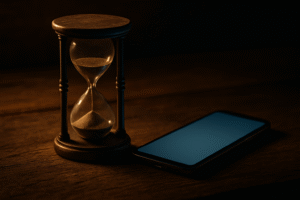
STATEPHONE vs. Dumbphone
A small, personal experiment in living more freely
I’ve given my smartphone a new name: STATEPHONE.
Why? Because more and more of life now seems to require “an app,” a login, a location ping, a push to turn notifications back on. Government services drift app-first. Big businesses quietly prefer the data trail. Convenience is lovely—but it’s not neutral.
So here’s my counter-move: I’ve bought a simple Nokia dumbphone for out-and-about life. The STATEPHONE stays at home on Wi-Fi, calls forwarded to the Nokia. Result: I’m reachable, but I’m not carrying the tracking, the infinite scroll, or the “one more tap” that eats hours and habits.
No doom, no drama. Just a nudge in the other direction.
What problem am I trying to solve?
- Default dependency: Tickets, banking, parking, even access to buildings—“use the app.”
- Ambient tracking: Location, motion, behaviour—some of it necessary, much of it optional, all of it cumulative.
- Attention tax: Every notification is a tiny tax on focus, mood, and time.
- Soft coercion: When everything prefers an app, choice quietly evaporates.
I’m not against tech. I’m against being defaulted into systems that treat my attention and data as their resource.
The principle (and the joke)
We’re not going dumb—the phones are.
The aim is to get wiser: fewer default permissions, fewer ambient demands, fewer micro-distractions. Simple device, sharper mind.
My setup (simple and boring, by design)
1) STATEPHONE stays at home
- On Wi-Fi, not on my person.
- Used deliberately for the few things that truly require it (banking, certain bookings, etc.).
- Updates and backups happen on my schedule.
2) Nokia dumbphone in my pocket
- Calls and SMS only (plus the built-in bits like alarm, calendar, torch).
- Long battery life, no feed, no app garden, no dopamine drip.
3) Call-forwarding
- All calls to the STATEPHONE number forward to the Nokia.
- If I miss a call, voicemail or a simple SMS sorts it.
- When I need to dive into an app, I do it later—from home.
⚠️ Note: Call-forwarding specifics vary by network. Some carriers charge a small fee for forwarded minutes. Check your plan’s “divert/forwarding” details before you flip the switch.
Day-to-day reality (pros & cons)
Pros
- Peace & battery: The Nokia lasts days; my brain lasts longer.
- Fewer pings, more presence: Real conversations, fewer reflex unlocks.
- Tighter privacy by default: No constant location + notifications = fewer breadcrumbs.
- Better boundaries: I choose when to enter the app world.
Trade-offs
- Fewer conveniences on the go: Some services really are app-gated. Plan around them.
- Maps/music on rides: Use standalone sat-navs or pre-printed notes if you want a pure dumbphone day.
- Two-step auth: Prefer hardware keys or SMS codes; do app-based 2FA at home.
- Social spontaneity: You might miss a group chat meme. You’ll live.
“But isn’t the STATEPHONE just a tool?”
Absolutely—and that’s the point. Tools should fit our purposes, not the other way around. When a tool slowly becomes a gatekeeper—where access, identity, and payment all live behind one glowing rectangle—then it deserves a healthy boundary.
This is my boundary.
A few practical tips if you want to try this
- Start with call-forwarding.
Set unconditional forwarding from your smartphone line to the dumbphone. Test voicemail and missed-call behaviour. - Harden the STATEPHONE.
Turn off location except when needed, review app permissions, uninstall time-sinks, remove lock-screen previews, and log out of what you don’t use. - Create “office hours”.
Choose a window each day to handle app-only tasks on the STATEPHONE at home. Batch it. Be done. - Have a print/analogue fallback.
Keep a small notebook, a pen, and (if relevant) a physical card or pre-booked QR printout for events and trains. - Expect friction for a week.
Then notice the quiet. That’s the trade working.
The bigger thought
I’m not campaigning for a bonfire of smartphones. I’m suggesting we re-balance: fewer assumptions that our lives must be lived through a single, trackable device. When enough of us choose differently—politely, persistently—the ecosystem adapts.
Until then, I’ll be out with the Nokia. The STATEPHONE can mind the house.
“Hope isn’t what they promise you. It’s how you carry on when they don’t deliver.” — Dave Carrera



